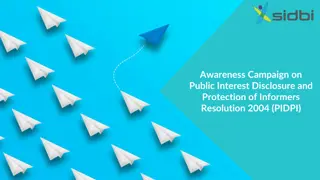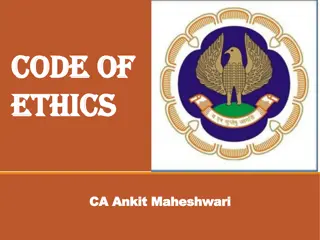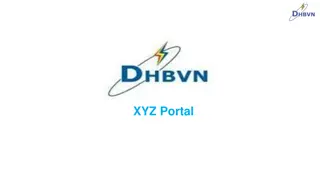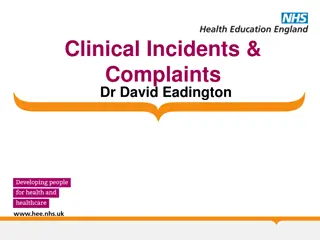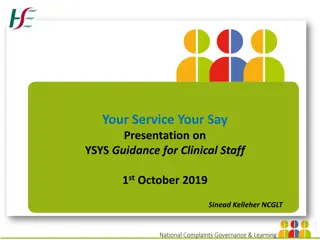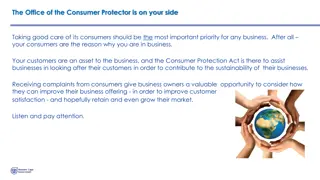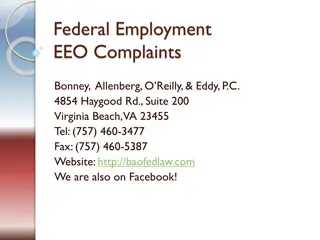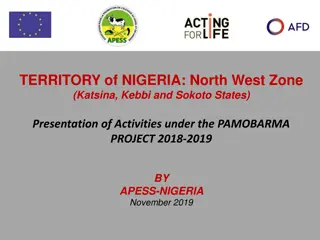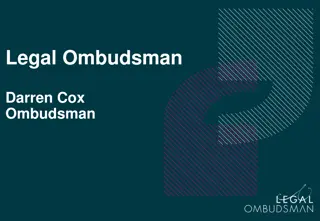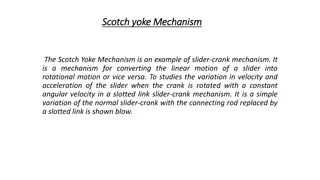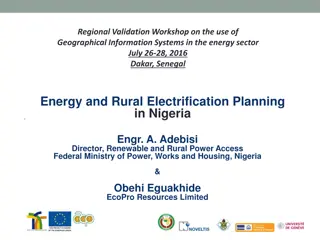Inter-Agency SEA Community Based Complaints Mechanism in Nigeria
The Inter-Agency SEA Community Based Complaints Mechanism in Nigeria facilitates safe and confidential reporting of complaints, particularly related to sexual exploitation and abuse (SEA), by beneficiaries. Through inter-agency coordination, this mechanism ensures effective collaboration, messaging, and referrals, enhancing accountability and survivor protection. The design incorporates stakeholder roles, guiding principles, complaint procedures, and mechanisms for investigations and sharing findings.
Download Presentation

Please find below an Image/Link to download the presentation.
The content on the website is provided AS IS for your information and personal use only. It may not be sold, licensed, or shared on other websites without obtaining consent from the author. Download presentation by click this link. If you encounter any issues during the download, it is possible that the publisher has removed the file from their server.
E N D
Presentation Transcript
Inter Agency SEA Community Based Complaints Mechanism - Nigeria
Why Inter Agency Coordination of PSEA CBCM in Nigeria Inter agency coordination of PSEA in Nigeria involves Collaboration in activities for messaging and awareness raising; Nominated FPs who meet regularly; Coordinating complaints and referrals for victims assistance A CBCM is a mechanism for receiving complaints from beneficiaries that is designed based on the input of the affected community and allows reports (including SEA) to be made safely and confidentially. Inter-agency aspect of a CBCM makes Reporting simpler for beneficiaries who may not know the agency that employs their abuser. The joint mechanism also ensures that the complaint will be referred to the appropriate agency for follow up and potential investigation.
Designing the Inter-Agency PSEA CBCM Agency self assessment checklist FPs training on Inter Agency Coordination of CBCMSupported by IOM and the global task force. 28 participants FPs from UN, INGOs, Government agencies Beginning of discussions (on going) Security actors such as the military involved in humanitarian response Government agencies, learning centres National civil society organisations Learning session for managers OHCT level Decision on establishing an inter agency PSEA CBCM Scope of the PSEA CBCM Reporting lines and accountability Assessment findings AAP and Safety Assessments 2018 PSEA Action Plan priorises the implementation of an inter agency PSEA CBCM
Content of the Mechanism 1. Introduction 2. The Mechanism 1. The design of the Inter Agency SEA CBCM 2. Scope of the Mechanism 3. Roles and responsibilities of the CBCM stakeholders 3. Guiding principles 4. Complaint mechanism procedures 1. Receiving complaints and reports through the CBCM 2. Processing complaints 3. Investigations 4. Inter agency sharing of investigation status and findings with the CBCM 5. Engagement, implementation and addressing challenges 6. Annexes
The Design of the Mechanism To enable the reception of allegations of SEA through an integrated complaints mechanism and the provision of referrals between the agencies in an effective, safe, confidential, transparent and accessible manner reducing impunity and ensuring protection of survivors and witnesses. Intended to enhance the implementation of each agency s existing Code of Conduct, policy, standards and regulations that guide the behaviour of personnel. Informed by findings from community consultations carried out by the Accountability to Affected Persons (AAP) working group focusing on existing community based complaints and feedback mechanisms. Enhanced by various reports from safety assessments conducted in selected IDP Camps by GBV Sub Sector partners that outlines some preferred channels for reporting for reporting GBV related concerns especially by women and girls. Been developed through discussions and consultations amongst the PSEA Network Focal Points and contextualized to the circumstances of conflict affected persons in Nigeria.
The Scope of the Mechanism Applies to members of the PSEA Network in Nigeria s humanitarian response While the geographical scope will primarily focus on the most conflict affected states in the North-East State, it will also apply in other states where the humanitarian leadership HCT/UNCT has activated the humanitarian response architecture. Applicable to all humanitarian staff, associated personnel, third party agreements, volunteers and actors participating in the PSEA Network It important to ensure strong linkages between the CBCM and other relevant accountability mechanisms and therefore appropriate referrals need to be ensured. Through developing formal cooperation and information sharing agreements with relevant institutions, to facilitate reporting and referral of SEA cases guided by the principles in this CBCM. Primarily focused on receiving and referring SEA complaints by humanitarian personnel, Internally Displaced Persons and host community members. - will have a means to record and transfer broader programme-related complaints to the relevant agency or sector for follow up.
Roles and Responsibilities HC/DHC: Overall leadership authority, Takes updates from PSEA coordinator; As HC, responsible for country reports on PSEA progress made in-country; Does advocacy at global level HCT/OHCT/Steering Committee: Senior Management representatives; Guidance and oversight; Make PSEA-related decisions for their agency; Regular progress meetings; Development of SOPs for CBCM; Maintenance of the CBCM PSEA Focal Points: Nominated agency staff; Face of the PSEA framework/CBCM to the community; Take complaints reporting; Conduct awareness-raising events; Regular collaboration meetings and participation in the PSEA taskforce/network PSEA Coordinator: Independent actor to push PSEA momentum; Champion the CBCM; Work with stakeholders and the Humanitarian Coordinator; Coordinate inter-agency meetings; Independent complaint review function PSEA Task Force/ Core team: Support the coordinator; perform the role of clearing house; field missions; strategic guidance
Guiding principles Receiving Complaints and Reports Survivor centred approach Safety & Well-Being Confidentiality Standards of Conduct Zero tolerance Transparency Feedback Accessibility Survivor centred approach Partnership and cooperation Special considerations for children SEA allegations may be reported by Directly by the survivor or Anyone who has a suspicion or a concern i.e humanitarian personnel, Internally Displaced Persons and host community members.
Reporting channels For affected persons Direct in person reporting - multiple entry points WGFS Child Friendly Spaces (CFS) Adolescent/youth friendly spaces Schools and learning or activity centress Complaints boxes Dedicate telephone helplines with SMS, email Protection desks Health care facilities Protection desks Through social care workers
Reporting channels For affected persons Key considerations for human engagement staff capacity; use of standardized Incident Report Form; collect minimum and only necessary information What happened, when, how complainant prefers to be contacted, date, what services have been provided . Reporting through community leaders key community FPs trained on how to refer complaints and what to expect in the referral process, and how to assist survivors in receiving support. Special considerations for children engagement with education and CP sector, UNICEF; entry points CFS, child activity centres, schools and learning centres. Protection principles and child safeguarding measures should be in place to avoid the chance of children been put at risk for taking part in the CBCM. Direct reporting to the concerned agency - Each agency should facilitate individuals to submit a complaint or make a report in whichever manner individuals feel most comfortable and safe to do so. Ensure their staff are aware on what to do when they receive a complaint or become aware of SEA incident.
Reporting channels For Humanitarian workers Agency responsibility to inform staff duty to report, agency s complaint and response policy and procedures; and of the role and how to contact its PSEA Focal Point Allegations can be against a co-worker in the same organisation or another organisation s staff Reporting through internally established mechanisms PSEA FP, investigative unit, management Refer to the other organisations FP Reports directly to the organisation and makes its way up the channel upto HQ If primary reporting channel is compromised CBCM, regional, HQ In these cases, agencies should notify the CBCM that complaints have been received and that these processes are ongoing.
Complaint Intake Protocols for interaction with beneficiary complainants Treat the complainant with respect and make him/her as comfortable as possible Address issues of confidentiality, explaining that there are limits obligation to report Ask only the number of questions required to gain a clear understanding of the complaint so that it can be referred to the appropriate agency s investigation unit Ask only relevant questions e.g , the status of the virginity of the survivor is not relevant and should not be discussed. Ensure that all information is well-documented during the in-person interview, so that the allegation can be immediately referred to the investigating agency. How the complainant prefers to be contacted Always ensure same sex interviewers and translators Make a written record of the complaint using a standard Complaint Intake Form
Processing complaints by the CBCM Receives the initial complaint preferably using the standardised incident report form Determines the immediate protection and assistance needs of the victim/ complainant; Preliminary assessment of immediate needs (independent of any administrative action) Referrals for services based on survivors needs and consent Refer the survivor to access appropriate victim protection services Establish the nature of the complaint assessing the complaint for referral Does the complaint potentially allege SEA? Is there enough information to refer the complaint? Who is the concerned agency? Identifying to which agency to refer the allegation All complaints must be assessed under strict conditions of confidentiality Refer the allegationto the appropriate agency (or Sector/accountability mechanism if non-SEA) for follow up Notify the complainant that his/her complaint was received (if not taken in-person); The PSEA/CBCM coordinator can request the PSEA task force to undertake a field mission to ascertain information in the air allegation, allegations received through field engagement The maximum CBCM processing time for a complaint before referral to the concerned agency will be as soon as reasonably possible, and no longer than 48 hours from the time the Coordinator receives the complaint.
Inter Agency Referral Pathway The PSEA/CBCM Coordinator directly forwards all SEA complaints through the SEA Complaint report form to the unit responsible for receiving SEA complaints within the agency/organization where the subject of the complaint is employed. All agencies agree to receive complaints referred from the PSEA/CBCM Coordinator or another entity in good faith and in the spirit of cooperation, in line with this Mechanism Agencies may receive complaints against another agency, or complaints may be made through an established body other than the agency directly concerned if there are concerns of breach in internal system All information shared must remain private and shared only on need to know basis To facilitate transparency, lessons learned, data tracking and the efficacy of the CBCM, agencies receiving internal SEA complaints should notify the CBCM Coordinator. The PSEA Coordinator or the respective Head of Agency (while notifying the Coordinator) will send confidential notification to the HC as Complaint under investigation . `
Inter Agency Referral Pathway To support safe, confidential and efficient inter-agency referrals, entities agree to the following procedures to receive and address complaints about another entity or from another entity The entity receiving the complaint is not responsible for investigating the complaint but must prioritise the safety of the survivor, witnesses, alleged perpetrator and other individuals who could potentially be affected, and should follow the procedures set out in this Mechanism. The entity receiving the complaint shall seek the consent of the complainant to refer the complaint to the PSEA Focal Point of the agency of concern or Investigative body. Complaints will be referred between the PSEA Focal Points of the entities involved in person and in writing (email or hand-posted letter) providing the necessary information available about the complaint or allegation using a standardised Complaint Referral Form Where in direct receipt of a complaint, the agency of concern shall ensure that the complaint is safely and appropriately investigated, either by itself or affiliated Investigative body as set out in this Mechanism. The entity PSEA Focal Point should acknowledge receipt of a complaint or report to the referring agency and confirm that the matter was addressed, in full consideration of confidentiality principles and the best interest of the survivor.
Investigations Always prioritise the protection of the survivor, his/her family members, witnesses and any other individuals who might be affected by an allegation or complaint and all entities will endeavour to cooperate to mitigate any potential risks during and following an investigation. Undertaken exclusively by dedicated personnel of the entity of concern or by the established Investigative body affiliated with that entity, that are charged with this responsibility and who have the necessary skills and competence to undertake such investigations appropriately. Each entity is responsible for ensuring adherence to its own internal investigation policies and procedures, in order to coordinate, manage, assess, investigate and respond to complaints or allegations of sexual exploitation and abuse. In the event an agency may lack the capacity to investigate internally, in which case the CBCM shall remain available to make a request to a standing pool of PSEA-trained investigators through the global CBCM task force.
Agency information sharing on investigations/findings/reports with CBCM Agencies agree, as a practical accountability tool, to share statistics on SEA cases reported and/or investigated, and disciplinary measures taken if any, CBCM whether or not the complaint was initially received through the CBCM. They should provide regular updates about the status of any investigation to the CBCM in writing and/or at regular meetings - in coordination with internal investigative policies and procedures Follow Data Protection Protocols and implement appropriate procedures to maintain confidentiality of all data gathered in relation to a complaint of sexual exploitation and abuse- paper file security, electronic data security For Data Tracking and Trends Analysis, the online Common Reporting Platform (CRP) developed by the global CBCM task force will be adopted for Nigeria and used by participating agencies as complaints repository for the PSEA CBCM. The CRP standardizes intake by the use of a common Incident Report Form, tracks case handling, collect the anonymized data in both a dashboard and map feature to assist in monitoring trends. Access strictly by authorisation. In the absence of the CRP, agencies agree to share information on SEA complaints using the reporting template with the PSEA Coordinator, who will compile the information into an anonymous quarterly PSEA report, to be shared confidentially with the Humanitarian Coordinator.
Thank you! 18








